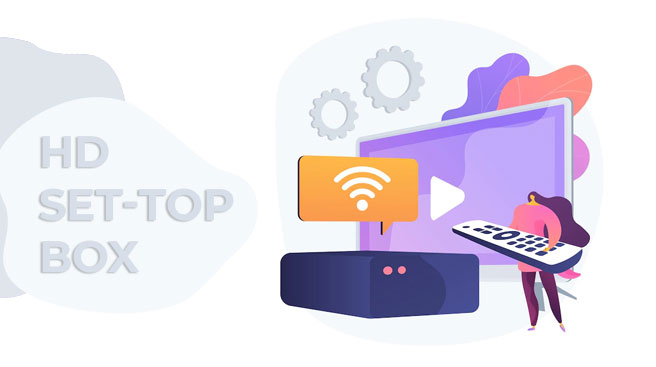What is the technology behind an HD set-top box?
An HD set-top box is a piece of hardware that receives digital signals, decodes them, and then displays the results on the TV. You can use a cable or a phone line to send Internet data instead of a television signal to the STB. The STB has evolved from a simple receiver and decoder to a considerably more engaging gadget in recent years. In other words, you can use your STB to make selections, send VOD requests, record programs, play them again on repeat, and so on. Cable converter boxes, TV signal sources, and professional STBs are only some of the numerous types of STBs available.
Curiosity: Inside of the box
When it comes to the STB, it's a simple box with a lot of connectors. Embedded devices have a variety of hardware components and software drivers to help them accomplish their goals. Either one processor is included or maybe more than one. The power supply, decoder, RF modulator, audio interfaces, RAM, and video interfaces, storage, flash, a front panel, and a front end make up the majority of the STB's components.
Terrestrial, cable, or satellite can be used for the front end, and a variety of video interfaces are available, including HDMI, component video, or CVBS. An analogue or digital Interface can be used for the audio interfaces (SPDIF).
Decoding is at the heart of the Set-top box. Front-end equipment takes in incoming data and transfers it to the decoder for further processing. A frequency-correction tuner will be integrated into the front-end design for those who require it. The STB's power supply and flash memory contain the boot loaders, as do most other devices.
Recordings of long-term data are stored on STBs and other storage devices. Video interfaces and audio interfaces assist with the sender and receiver of video and audio, respectively.
IR input/output, an LED status display, and a few switches for connecting and setting the STB may be found on the STB's front panel. All of these functions are handled by the STB's processor, which could be a general-purpose one or a dedicated one. When audio and video signals are sent into an RF modulator, they have transformed into radio frequency (RF) signals.
What else is there to discover outside an HD Set-top Box?
When a signal is received, the STB's tuner and demodulator determine which channel to use. The television will receive audio and video output from the decoder. Many moving pieces make it difficult to comprehend how this cycle operates. CAS inputs can be used to decide the output of the decoder, for instance. There are also Teletext and subtitling options available here.
Summary
Although the basic functionalities of an STB have been described above, the type of service supplied may necessitate more complex hardware and software systems. Given the pleasant experience of people, the set-top box is a hit among the commons.
Curiosity: Inside of the box
When it comes to the STB, it's a simple box with a lot of connectors. Embedded devices have a variety of hardware components and software drivers to help them accomplish their goals. Either one processor is included or maybe more than one. The power supply, decoder, RF modulator, audio interfaces, RAM, and video interfaces, storage, flash, a front panel, and a front end make up the majority of the STB's components.
Terrestrial, cable, or satellite can be used for the front end, and a variety of video interfaces are available, including HDMI, component video, or CVBS. An analogue or digital Interface can be used for the audio interfaces (SPDIF).
Decoding is at the heart of the Set-top box. Front-end equipment takes in incoming data and transfers it to the decoder for further processing. A frequency-correction tuner will be integrated into the front-end design for those who require it. The STB's power supply and flash memory contain the boot loaders, as do most other devices.
Recordings of long-term data are stored on STBs and other storage devices. Video interfaces and audio interfaces assist with the sender and receiver of video and audio, respectively.
IR input/output, an LED status display, and a few switches for connecting and setting the STB may be found on the STB's front panel. All of these functions are handled by the STB's processor, which could be a general-purpose one or a dedicated one. When audio and video signals are sent into an RF modulator, they have transformed into radio frequency (RF) signals.
What else is there to discover outside an HD Set-top Box?
When a signal is received, the STB's tuner and demodulator determine which channel to use. The television will receive audio and video output from the decoder. Many moving pieces make it difficult to comprehend how this cycle operates. CAS inputs can be used to decide the output of the decoder, for instance. There are also Teletext and subtitling options available here.
Summary
Although the basic functionalities of an STB have been described above, the type of service supplied may necessitate more complex hardware and software systems. Given the pleasant experience of people, the set-top box is a hit among the commons.



Comments
Post a Comment